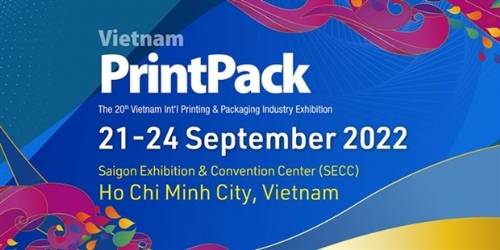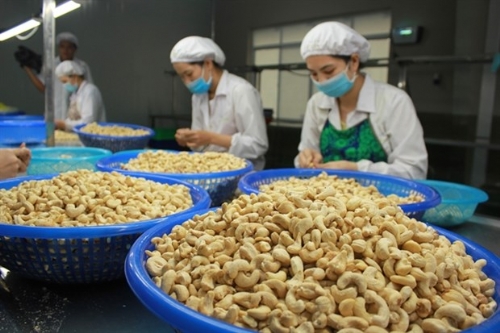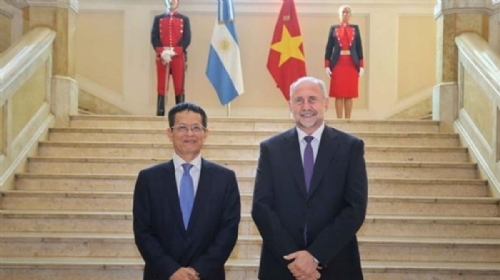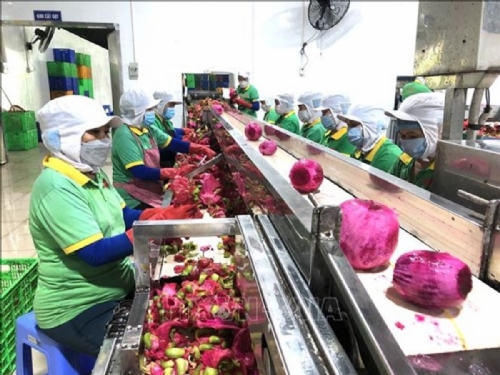VN needs to develop raw materials production to take advantage of EVFTA
Tuesday, September 22, 2020 10:06
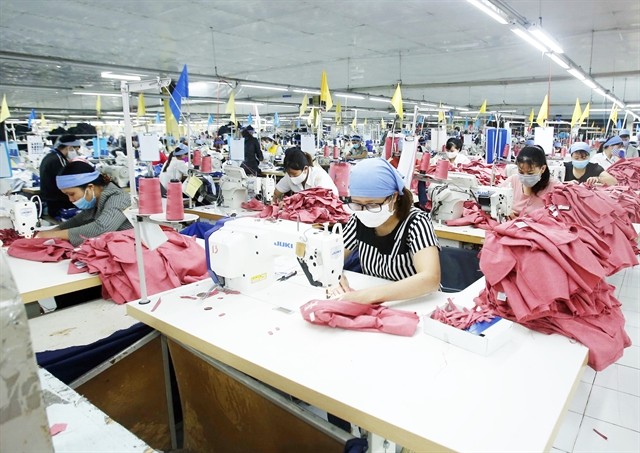
Processing of garment products at the Tiên Hưng Garment Joint Stock Company in Hưng Yên Province. In 2019, Việt Nam's textile and garment export value to the EU reached $4.3 billion, 3.8 per cent higher than 2018. — VNA/VNS Photo Phạm Kiên
HÀ NỘI — A shortage of raw materials remained an obstacle that needed to be removed if Vietnamese textiles and garments enterprises want to seize export opportunities in the EU under the Việt Nam-EU Free Trade Agreement (EVFTA), according to experts.
The Ministry of Industry and Trade (MoIT) said the European Union (EU) had the largest demand for textiles and garments in the world with an import value of about US$250 billion per year.
In 2019, Việt Nam's export value to the EU reached $4.3 billion, 3.8 per cent higher than 2018. However, Việt Nam accounted for only about 2 per cent of this market which was very small compared to the demand.
The EVFTA, effective from August 2020, was expected to help Việt Nam’s textile and garment industry to increase its exports to the EU by about 67 per cent by 2025 compared to the scenario without this agreement, according to the MoIT.
However, according to the commitments of the EVFTA, besides meeting strict quality criteria, to enjoy preferential tariffs local businesses must implement strict origin requirements. Specifically, the EVFTA requires rules of origin to apply from fabric onwards, meaning that exports to the EU must use fabric produced in Việt Nam or the EU. The agreement also allows firms to use fabric from countries which have FTAs with both Việt Nam and the EU.
This issue is still a weakness for the local textile and garment industry because most raw materials are imported from countries that have not signed FTAs with the EU.
Accordingly, local textile and garment producers should use local material for products that were going to be exported to the EU, but many of them were still unaware of the origin of the raw materials they were using, said Vũ Đức Giang, chairman of the Việt Nam Textile and Apparel Association. Meanwhile, new-generation FTAs such as the Comprehensive and Progressive Agreement for Trans-Pacific Partnership (CPTPP) and EVFTA had very strict regulations on materials and manufacturing processes.
Bùi Kim Thùy, a former member of Việt Nam's negotiation delegation for FTAs and country representative on the US-ASEAN Business Council, said to solve this issue, the textile and garment industry could initially use fabrics imported from countries that had FTAs with the EU such as South Korea to enjoy the preferential tax rates of the EVFTA.
But the amount of fabric imported from South Korea was low due to distance and price. Therefore, in the long term, Việt Nam needed a comprehensive strategy to seize opportunities provided by the EU market, Thùy said.
To enter the EU, many businesses have invested in factories, technology, machinery and the implementation of technical standards for this export market.
Trần Như Tùng, a member of the Thành Công Textile and Investment Joint Stock Company (TCM)’s board of directors, said with benefits from the EVFTA, the company aimed to increase its exports to the EU by 30-50 per cent. It had also built a fabric dyeing factory to meet the demand for production.
In the long term, the company planned to open another fabric dyeing factory in the southwest region. That would help to provide enough raw materials for production, Tùng said.
Chairman of the Việt Thắng Jean Company’s board of directors Phạm Văn Việt said to meet the EVFTA’s origin requirements, Việt Thắng Jean had signed contracts to purchase raw materials from partners in South Korea and Turkey instead of China.
Besides these efforts from businesses, according to experts, the Government should issue a development plan for industry sectors until 2040, including textiles, garments, leather and footwear, to produce raw materials for the textile and garment sector according to the rules of origin set out in the FTAs.
At present, the MoIT is completing a development plan for the textile and garment industry until 2040 to develop large-scale textile and dyeing industrial parks with wastewater treatment systems that reach international standards to attract investors.
Giang said this plan must focus on building textile industrial zones with modern wastewater treatment to encourage investment and complete the cycle of weaving - dyeing - sewing.
That would help the domestic textile and garment industry join the global supply chain and reduce the dependence on imported materials as well as take full advantage of the EVFTA and other FTAs, he said.
The State also needed to adjust tax policies on imported goods and raw materials imported for production of export goods, creating more favourable conditions for businesses.
Trần Thanh Hải, deputy director of the MoIT’s Import and Export Department, said both the Government and local businesses need to act at the same time to take full advantage of the EVFTA.
Accordingly, the Government needed to develop support industries to meet the local demand for raw materials and to increase the localisation rate so export goods met the rules of origin. Initially, Việt Nam should look at attracting investment projects in the textile and dyeing industry, especially projects that used advanced technological equipment and environmentally friendly wastewater treatment processes.
For local businesses, Hải said they needed to study the tariffs and rules of origin outlined in the EVFTA and adjust their production processes and sources of raw materials accordingly.
In recent years, the MoIT has implemented policies to develop the support industries for various sectors, including textiles and apparel. It has also opened a database on the support industry, including information about 1,400 enterprises in the textile and garment industry. — VNS
Other news
- HCM City to host Vietnam Print Pack 2022 expo(9/16/2022 11:02:26 AM)
- Medical-pharmaceutical, beauty products exhibitions open in HCM City(9/16/2022 10:58:48 AM)
- Firms must work to fully benefit from UKVFTA: Insiders(8/24/2022 3:15:30 PM)
- Vietnam, Argentina boost trade cooperation(8/23/2022 3:51:49 PM)
- Workshop helps fresh fruit exporters learn about China’s new regulations(8/23/2022 3:47:36 PM)
- HCM City to host Int'l Textile & Garment Industry Exhibition(8/23/2022 3:11:55 PM)
- Saigon Autotech & Accessories Show to be held in late October(8/19/2022 8:38:38 AM)
- Vietnamese handicrafts go on sale at New York Now 2022(8/18/2022 8:52:55 AM)
- Week of OCOP products launched in Hanoi(8/17/2022 8:39:01 AM)
- Trade fair looks to expand “One Commune One Product” markets(8/16/2022 11:21:14 AM)


